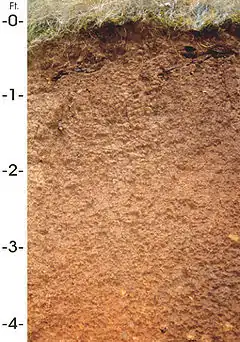Jory (soil)
The Jory series consists of very deep, well-drained soils that formed in colluvium derived from basic igneous rock. These soils are in the foothills surrounding the Willamette Valley of the United States. They have been mapped on more than 300,000 acres (1,200 km2) in western Oregon. They are named after Jory Hill, Marion County, Oregon, which itself is named for the Jory family, who settled in the area in 1852, after traveling along the Oregon Trail.
- Surface layer: organic material
- Subsurface layer: dark reddish brown silty clay loam
- Subsoil - upper: dark reddish brown clay
- Subsoil - lower: red clay

Jory soils generally support forest vegetation, dominantly Douglas fir and Oregon white oak. They are very productive forest soils. Many areas have been cleared and are used for agricultural crops. The Jory soils and the climate of the Willamette Valley provide an ideal setting for the production of many crops, including Christmas trees, various berries, filberts (hazelnuts), sweet corn, wheat, and many varieties of grass seed. The soils are suitable for the grapes used in the expanding Oregon wine industry.
Growing urbanization of the Willamette Valley is resulting in a great deal of pressure for development in areas of the Jory soils.
Oregon state soil
After several failed attempts to make it an official state symbol, Jory was officially adopted as the state soil of Oregon by the Oregon Legislative Assembly in 2011.[1][2][3]
References
- Natural Resources Conservation Service (2003). "Jory -- Oregon State Soil". State Soils. USDA. Archived from the original on 2007-03-13. Retrieved 2008-02-10.
- "House Concurrent Resolution 3, 2011". Oregon State Legislature. 2011. Archived from the original on August 5, 2012. Retrieved May 24, 2011.
- Mapes, Jeff (May 24, 2011). "Jory soil, not just any dirt, is named Oregon's state soil". The Oregonian. Retrieved May 24, 2011.
- Mapes, Jeff (May 19, 2011). "Here's the dirt: Senate votes down bill to make Jory soil the official soil of Oregon". The Oregonian. Retrieved May 19, 2011.